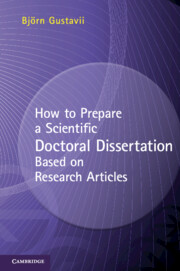Book contents
- Frontmatter
- Contents
- Preface
- Acknowledgments
- 1 Introduction
- 2 Compilation – the article-based thesis
- 3 Front cover illustration
- 4 Title
- 5 Abstract
- 6 Quotations
- 7 Thesis at a glance
- 8 Abbreviations
- 9 List of publications
- 10 Contributors
- 11 Popularized summary
- 12 Acknowledgments
- 13 General introduction
- 14 Aims
- 15 Methods
- 16 Results
- 17 General discussion
- 18 Copyright
- 19 A dissertation worth considering
- Appendix A To the authorities at the graduate division
- Literature cited
- Index
7 - Thesis at a glance
Published online by Cambridge University Press: 05 November 2012
- Frontmatter
- Contents
- Preface
- Acknowledgments
- 1 Introduction
- 2 Compilation – the article-based thesis
- 3 Front cover illustration
- 4 Title
- 5 Abstract
- 6 Quotations
- 7 Thesis at a glance
- 8 Abbreviations
- 9 List of publications
- 10 Contributors
- 11 Popularized summary
- 12 Acknowledgments
- 13 General introduction
- 14 Aims
- 15 Methods
- 16 Results
- 17 General discussion
- 18 Copyright
- 19 A dissertation worth considering
- Appendix A To the authorities at the graduate division
- Literature cited
- Index
Summary
Thesis at a glance first appeared in a thesis by Elke Theander in 2005, at Lund University (Figure 7.3). Although this section has become popular in the local region, it has not yet – in 2011 – been recognized at other universities.
A Thesis at a glance could be described as an abstract of the abstracts and is extremely helpful to the reader. However, avoid including drawings, graphs, or tables in the one-page variant. They will be reduced too much to be readable (Figure 7.1). If you really need illustrations, you may want to use two pages, where pictures and tables can be made large enough to be legible (Figure 7.3). In the two-page variant, the pages should face each other, to allow readers to see the content at a glance.
No instructions for writing a Thesis at a glance exist. Its layout depends on the subject and the results obtained. On the following pages you will find four examples of Thesis at a glance. They are illustrative with respect to the layout.
Information
- Type
- Chapter
- Information
- Publisher: Cambridge University PressPrint publication year: 2012
